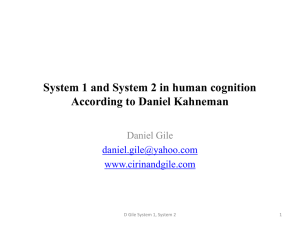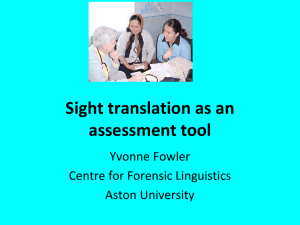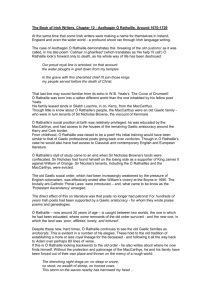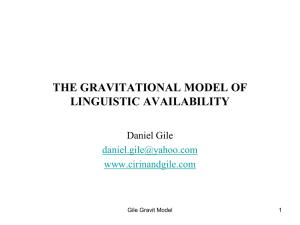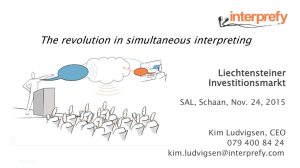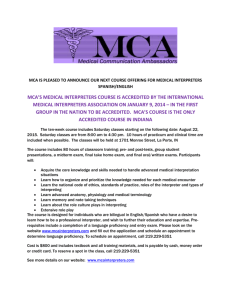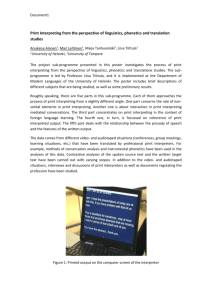Diapositive 1
advertisement
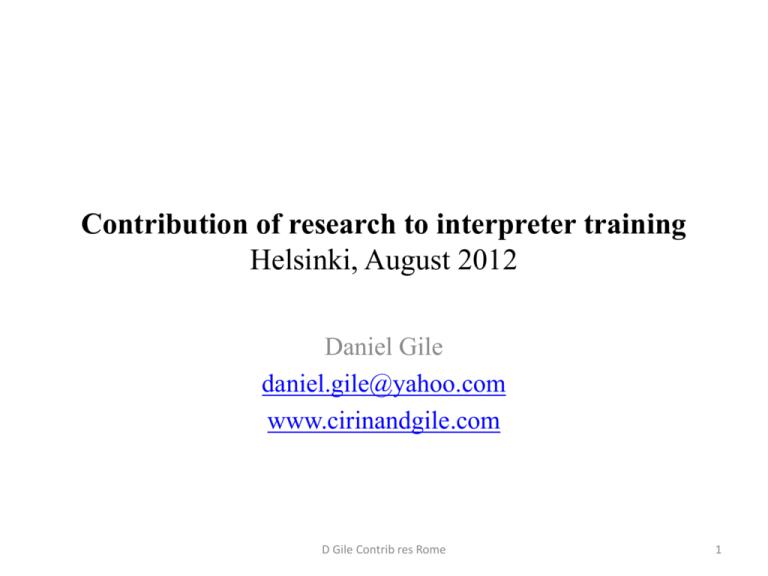
Contribution of research to interpreter training Helsinki, August 2012 Daniel Gile daniel.gile@yahoo.com www.cirinandgile.com D Gile Contrib res Rome 1 Introduction In this overview and analysis, will include “pre-theoretical”/PRG contributions, theoretical contributions, empirical contributions: In the field, the boundaries between PRG and “proper research” are often fuzzy And when focusing on the contribution to training, Information, including information on prescriptive positions, can be valuable regardless of its academic/scientific status. D Gile Contrib res Rome 2 PRG (1) Hundreds of publications, including dozens of books. Well-known examples in the “West”: Rozan 1956 La prise de notes en consécutive Seleskovitch & Lederer 1989 Pédagogie raisonnée de l’interprétation Basis for AIIC paradigm Teach interpreting, not languages (languages supposed to have been mastered fully before admission) Instructors are practicing interpreters Consecutive before simultaneous, no shorthand Work into A Ad-libbed speeches with live speaker Authentic material… D Gile Contrib res Rome 3 PRG (2) In Western Europe, this was virtually the training paradigm A number of publications along those lines Virtually no ‘dissidents’ (but for instance Raúl Galer, 1974 on shorthand in consecutive) In other parts of the world, different practices Perhaps because different conditions, such as: - Work into B sometimes seen as necessary or even desirable - Separation between language enhancement and interpreting not always clear - Different views about consecutive preceding simultaneous Even in ‘Western’ countries Trainers did not necessarily follow “the rules” D Gile Contrib res Rome 4 From the end of the 1980s on 1986 Trieste conf. on interpr. training (Gran and Dodds 1989) Some aspiration for more ‘scientific’ research for interdisciplinary research The movement included AIIC members Jennifer Mackintosh, Catherine Stenzl, Ingrid Kurz, Barbara Moser-Mercer (not AIIC at that time?), Daniel Gile… To be joined in the 1990s by others, in particular by Miriam Shlesinger & Franz Pöchhacker More info dissemination of between countries and schools The Interpreters Newsletter Later Interpretation Research (Tokyo) Interpreting (Moser-Mercer, now Pöchhacker & Shlesinger) D Gile Contrib res Rome 5 The literature - Books Textbooks More in China, in Russia Mostly describe, prescribe and suggest for training Sometimes with some/much backing from PhD research PhDs: Gile 1984, 1989, Sawyer on curriculum 2001… Proceedings of conferences on training In particular : John Benjamins series, 3 volumes with Cay Dollerup + 2nd editor (1992, 1994,1996), Tennent (2005) Note that in such proceedings, also papers on translator training …and in Benjamins Translation Library, books on translator training as well D Gile Contrib res Rome 6 Translator training & Interpreter training Much common ground: Acquisition of skills more than content Language-related skills Sometimes culture-gap related problems Problems with insufficient language skills of trainees Role of trainers and training philosophy (prescribers, guides, moderators, catalysts…) Assessment issues Admission issues Ethics issues Professional issues … D Gile Contrib res Rome 7 The literature – papers In proceedings of conferences on training But also in proceedings of general Translation conferences …. and in journals (Not only in the specialized journal The Interpreter and Translator Trainer) Can identify them in online announcements and in online journals See CIRIN site for list of and links to online journals www.cirinandgile.com D Gile Contrib res Rome 8 Theses and dissertations More difficult to find because most often unpublished, Especially MA theses, but perhaps (at least) just as interesting because often done with considerable investment of time and effort: MA/graduation theses and doctoral dissertations Many of those directly related to conference interpreting are listed, and generally micro-reviewed in CIRIN Bulletin. D Gile Contrib res Rome 9 Bibliographical basis for this analysis Read systematically CIRIN Bulletins over the past 5 years (focus of seminar being on ‘recent research’) Picked up a bit over 100 items which I considered relevant to the theme Classified them under different topics Comments also based on personal knowledge of the topics and literature Will mention them briefly as pointers With a few bits of information Sometimes with comments The items are identified by date of author(s), date of publication and CIRIN Bulletin number (in parentheses) D Gile Contrib res Rome 10 Training vs no training (1) Lederer, Marianne. 2008. (36) “The aim of training courses is to avoid would-be translators having to learn slowly by trial and error while looking for the most adequate strategies” Hong, Hsiao-Wen. 2001. (34) MA, Taiwan Normal University Trained and untrained interpreters compared with respect to fidelity and to delivery. No differences found in fidelity Differences found in delivery D Gile Contrib res Rome 11 Training vs no training (2) What does this tell us? Do we know untrained interpreters? Have we observed some things they do not do correctly? (Bill Weber 1984) Is this perhaps what we need to focus on when training students? Or do we consider that the main advantage of training is to make them progress faster? DEBATE D Gile Contrib res Rome 12 Aptitude testing (1) Major problem, because high failure rate Can one find reliable indicator for efficient admission? Special issue of Interpreting 13:1(2011) on the topic Interesting review and comparisons by Mariachiara Russo 2011, (44) Paper on SynCloze test by Franz Pöchhacker 2011(44) Auditory cloze exercise + synonimic sentence completions Moderate correlations found Rosier et al., Shaw 2011 (44) on soft skills/personality traits None shows the way to efficient high prediction-rate aptitude testing D Gile Contrib res Rome 13 Aptitude testing (2) Suggest that it will be difficult to design aptitude tests with strong predictive power But that personality and ‘soft skills’ are important Implications for the classroom? DEBATE D Gile Contrib res Rome 14 Testing (1) Huang, Min. 2005 (32) On accreditation tests in China Real ‘industry’, more language proficiency than interpreting skills (?) Chiu, Yu-Hsien. 2006 (34) MA thesis, Taiwan Several quantitative approaches to assess difficulty of texts, Including readability formulas, proposition density, density of new arguments, expert judgment None of the difficulties assessed by the four approaches correlated with participants’ interpretation scores Liu, Minhua & Chu, Yu-Hsien. 2009 (40) Same … D Gile Contrib res Rome 15 Testing (2) If it is difficult to test the difficulty of materials ‘objectively’ in advance, any other practical way? DEBATE Gile suggestion: Interpreting of authentic recorded speeches by panel of professionals, Each rates the difficulty If agreement, choose one or several D Gile Contrib res Rome 16 Training methods. Ideas and findings (1) Warning: Not many empirical studies Few replications Tendency to report successful operations only Possible bias of trainers who present their ‘baby’ So in terms of research ‘proper’, the harvest may look poor … But interesting ideas to try out D Gile Contrib res Rome 17 Training and sight translation Wang, Ying. 2006. (35) MA, Guangdong Effect of sight-translation exercises. Helped a lot in interpreting into English, not much into Chinese Perhaps because improved production skills? If so, is this the best way to enhance production skills? D Gile Scientif interpr intro 18 Training and shadowing Peng, Bo. 2008. (36) MA, Xiamen Effect of shadowing exercises. Reports shadowing helps, but no details are given in abstract. Note: Shadowing has been a controversial exercise from the start. Widespread, but reportedly as a short transitional exercise. On the other hand, it could be useful for language enhancement. Empirical studies on the topic would be welcome D Gile Scientif interpr intro 19 Training and summaries Cheung, Andrew Kay-Fan. 2007. (36) Effect of “summary exercises” Small differences between experimental and control group, but not significant. Summarizing requires understanding, being able to separate the gist from the less important, and reformulating. Useful skills for interpreters. When and in what form could such exercises be conducted? D Gile Scientif interpr intro 20 Training methods – conference simulation Lee, Migyong 2005 (31) Benefits of creating actual conference settings (mock conferences) Point made: Some aspects of conference communication too subtle to explain in traditional classroom situation Also – concerns about validity of classroom training and lab experimenting as opposed to real-life situations. Clearly, all real-life parameters cannot be replicated in the classroom… but: Vik-Tuovinen 2011 (44) In lab, professionals referred to clients when commenting on their decisions (similar results in research on translation). So not so problematic? D Gile Scientif interpr intro 21 Training methods – theatrical training Cho, Jinhyun & Peter Rogers. 2010. (41) In Korea. Training in theatre techniques revealed significant benefits in terms of confidence, delivery and rapid problem-solving activities If not the full range of ‘theatrical training’, perhaps voice? D Gile Scientif interpr intro 22 Training methods – self-assessment Lee, Yun-Hyang. 2005. (34). Take home recordings and do self assessment. All students found the exercise useful. Note: much work, requires a lot of time, painful? Demoralizing? Or particularly useful because students have the opportunity and time to actually listen to themselves? Or useful and potentially demoralizing, in which case these exercises should be handled with care so as to produce the best effect? D Gile Scientif interpr intro 23 Training methods – with third language Pyoun, Hewon. 2006. (34). Students found it difficult to interpret when the screen was in a third language Note: Specific training required? D Gile Scientif interpr intro 24 Training methods – pronunciation Cho Junmo, Park, Hae Kyung. 2006. (34). Pronunciation problems and suggestions for pronunciation training. Note: Pronunciation is very important for comprehension and listener satisfaction. If selection of students with right pronunciation is not possible at admission, perhaps systematic training for those who need it? “Accent trainers”? Might boost considerably chances of success of some graduates whose accent is not very good? D Gile Scientif interpr intro 25 Training methods – textbooks Wang, Jinbo & Wang, Yuan. 2006. (34). Review of 31 Chinese textbooks. Authors criticize weaknesses in theoretical foundation, methodology, authenticity of material. Discussion of usefulness of textbooks? In the West, sometimes for conceptual/methodological guidance (note taking, general advice) In China, Japan, with materials, including language materials Is it absurd? Perhaps not, if material well chosen If possibility to listen to good pronunciation To automate some relevant ‘equivalences’ D Gile Scientif interpr intro 26 Technology in training Blasco Mayor. 2005. (31) General, on technology in the classroom Sandrelli, Analisa & Jesús de Manuel Jerez. 2007. (35) Description of several tools of CAIT (Computer Assisted Interpreter Training) Maresova, Julie. 2009. (39) Using PRAAT software and questionnaire, interpreters shown to experience difficulties when prosody in SL is inadequate Orlando, Marc. 2010. (42) Digital pen technology for monitoring of students’ note-taking skills DEBATE D Gile Scientif interpr intro 27 Assessment and quality perception (1) Collados Aís, Prada Macías, Stévaux, Garcia Berrera (eds). 2007. (35), 2011 (43) Along with individual MA theses and doctoral dissertations by the ECIS group Manipulation of various parameters. Intonation Terminology Accent Language output quality … Spill-over effect found regularly D Gile Contrib res Rome 28 Assessment and quality perception (2) Lee, Jieun. 2008 (37) Study of rating scales. Successful for accuracy, Not for TL quality and delivery Li, Ying-Hong. 2008 (40) Research into music performance assessment has been taken to a greater depth than corresponding research on interpreting assessment. Learning opportunities Wang et al. 2008. (36) Survey, followed by in-depth interviews. Bilinguals and monolinguals have different expectations. Speakers, interpreters and listeners do not agree on the interpreters’ role either D Gile Contrib res Rome 29 Assessment and quality perception (3) Ippoliti, Matteo. 2005 (31) Respondents perceived fewer pauses and hesitations in interpreting than were present Pradas Macias, Macarena. 2006 (32) Effect of silent pauses on interpreting not significant on quality perception. Toyama & Matsubara. 2005. (32) Same. D Gile Contrib res Rome 30 Assessment and quality perception (4) Previously, evidence suggesting that listeners do not perceive meaning errors accurately (Gile 1995, Collados Aís 1996) Also previous evidence that language quality perception not uniform (Gile 1985) Knowledge from the field that expectations diverge greatly in some cases (TV interpreting vs court settings vs conferences) Findings suggest that there is high variability And that, importantly, single parameters (intonation, grammar, accent etc.) Can make a big difference in quality perception. Implications for the classroom? D Gile Contrib res Rome 31 Assessment and quality perception (5) 1. Awareness that accurate rendition and good output language quality are not the only things that matter to delegates 2. Focus on relevant aspects, including intonation and voice (special voice training?), terminology 3. Teach sensitivity to various norms and expectations, including TV, legal settings etc., and adaptation OTHER? D Gile Contrib res Rome 32 General cognitive issues (1) For a long time, awareness of the fact that besides insufficient language skills and insufficient general and thematic knowledge, a major issue in interpreting is the limited availability of attentional resources to meet the high cognitive load associated with interpreting. This was present, implicitly or explicitly, in many models/accounts of interpreting… D Gile Contrib res Rome 33 General cognitive issues (2) …and was the focal point of the Effort Models, developed in the early 1980s and first described in a publication in 1983. Also in many other publications since then Reception + Short-term Memory + Production + Coordination R + M + P + C → Total ≤ Available Resources Note: “Reception” as opposed to “Listening” to take on board visual reception by signed language interpreters Tightrope hypothesis : Interpreters tend to work close to cognitive saturation How “close” was not quantified, But close enough to make interpreters vulnerable to - Increase in resource requirements - Errors in resource management D Gile Contrib res Rome 34 Tightrope Hypothesis and numbers (1) Many studies testing, on basis of Tightrope Hypothesis, that numbers would be a problem (in particular those that need conversion for syntactic reasons or because the systems are different) Either the numbers are omitted or rendered incorrectly Or neighboring segments would be affected Because of carry-over effect (Too much attention focused on numbers, not enough left to deal with neighboring segment) Mazza. 2000, 2001. (25) Gotri. 2003. (27) Wang, Hsiu-Yu. 2005. (34) Puková, Zdeňka. 2006. (33) Pinochi, Diletta. 2006 (33). 2009.(40) D Gile Contrib res Rome 35 Tightrope Hypothesis and numbers (2) So idea of training students in number conversion, for instance in Chinese: Her, Emily. 1995 Cheung, Andrew. 2008. (37) Thirty minutes of training. In context apparently better than in isolation Moratto, Riccardo. 2011. (44) Various techniques D Gile Contrib res Rome 36 Translation and interpreting (1) Interpreting is done under more cognitive pressure than translation, so presumably less time and resources to produce output of maximum quality Tactics Cognates More or less literal? D Gile Contrib res Rome 37 Translation and interpreting (2) Shlesinger, Miriam & Brenda Malkiel. 2005. (35) Interpreting, Translation after 4 years. More cognates and false cognates in interpreting ***Jakobsen, Jensen & Mees. 2007. (35) Processing of 12 idiomatic expressions in two texts translated into Danish by five professional translators and sight-translated by five professional interpreters. - Translators preferred non cognates, then direct transfer, then paraphrase Interpreters preferred paraphrase, non cognates, direct transfer - Individual variation was “huge” - Direct transfer took interpreters a long time (perhaps avoidance first) D Gile Scientif interpr intro 38 Translation and interpreting (3) ***Dragsted & Gorm Hansen. 2007. (35) Translators translated first part and sight translated second part of speech Interpreters sight translated first part, simultaneous of second part Gaze data showed interpreters looked more locally Sight translation by interpreters was much faster than by translators Interpreters turned out to be less literal than translators The translator’s translations were not better than the interpreters’ sight-translation. Shlesinger, Miriam. 2008. (37) (same corpus as Shlesinger and Malkiel 2005?) Same source text interpreted, then translated > 3 years later Analyzed with software. Richer in translation, more complex structures, fewer imports from English, etc. D Gile Scientif interpr intro 39 Cognitive pressure and directionality (1) Presumably, interpreters are capable of producing acceptable speech in B under everyday conditions, and even in consecutive. Otherwise, what is the point of the B language classification? So why would they not be able to produce a good speech into B in simultaneous? Because: 1. Higher cognitive pressure on production in simultaneous (in consecutive, production of target speech only occurs after reception of the source speech) D Gile Scientif interpr intro 40 Cognitive pressure and directionality (2) 2. Higher risk of language interference because both sourcelanguage and target-language structures are simultaneously present in working memory/ are highly activated De Groot, Annette & Ingrid Christoffels. 2007. (38) About processes and mechanisms of bilingual control. When elements from one language are activated, so are those of the other, but they need to be inhibited, which has a cost (in attentional resources) D Gile Scientif interpr intro 41 Research on directionality and implications (1) Bartlomiejczyk, Magdalena. 2006a. (33) English and Polish. Did not find more lexical transfer when working into B than into A (students) Bartlomiejczyk, Magdalena. 2006b. (33) Strategies different when working into A or into B Palka, Alina. 2006. (35) Interpretations into B assessed by native user, positive overall evaluation Chang, Chia-chien & Diane L. Shallert. 2007 (35) Ten professional interpreters, dominant Chinese or English. Interpreters tend to develop different strategies into A and into B Bartlomiejczyk, Magdalena. 2008. (39) More anticipation into Polish, but more successful into English (questionnaire) D Gile Scientif interpr intro 42 Research on directionality and implications (2) Opdenhoff, Jan-Hendrik. 2011. (44) PhD Granada Web questionnaire survey. 2129 respondents (conference interpreters), from 94 countries. 96,1% of respondents have already worked into B 81,2% think it is “absolutely legitimate”; 18% “necessary evil” 40% consider their performance is of equal quality in both directions 40% consider it is better in their A language Respondents say some languages easier to interpret from than others D Gile Scientif interpr intro 43 Research on directionality and implications (3) Implications: Many (most?) graduates will have to work in both directions Since tactics and strategies may be different, and since developing them takes time, They should be trained in both directions DEBATE D Gile Scientif interpr intro 44 Deverbalization (1) One key idea in interpretive theory, which has been highly influential throughout AIIC is that the principles of interpreting are the same whatever the working languages and provided the interpreter has mastered the fundamental deverbalization process and the languages There are no more difficulties in interpreting between any language pair in any direction Deverbalization: After comprehension, all traces of the ST form disappear And what remains is only the ‘sense’ on the basis of which the interpreter reformulates the message D Gile Scientif interpr intro 45 Deverbalization (2) In cognitive terms: in the 1960s, psychologists found that after clause boundaries memory for form faded rapidly in readers Working memory (where signals are processed until they yield recognition of language units and meaning) has very limited storage capacity: perhaps around 7 information chunks, perhaps less Listeners cannot afford to keep information in WM when it is no longer needed. Once sense has been extracted, form is no longer needed In interpreting, ‘deliberate’ forgetting of form also mentioned. (to fight interference?) D Gile Scientif interpr intro 46 WORKING MEMORY AND LONG-TERM MEMORY A METAPHOR - COMPREHENSION EXT. STIMUL. sensory mem. LONG-TERM MEMORY Gile Effort Models WORKING MEMORY 47 Deverbalization (3) But perhaps form and sense are associated in some cases in long-term memory Perhaps form helps remember meaning because of its structure So ‘total’ deverbalization i.e. complete loss of memory of form is no longer seen as true Ito-Bergerot, Hiromi. 2006. (33) PhD, ESIT Deverbalization only partial Zhou, Shudan. 2008. MA, Shanghai SISU Test of form recognition by interpreters after interpreting and listeners after listening to same speech. No difference. So interpreters do not ‘deverbalize’ more than ordinary listeners? D Gile Scientif interpr intro 48 Language-specificity But if deverbalization-reverbalization are not the sole key of interpreting… and meaning can be related to form Perhaps more attention should be devoted to form during training? Even comparisons of form in working languages? Comparative linguistics useful for awareness raising? D Gile Scientif interpr intro 49 Working memory Known to be heavily involved in cognitive operations, including language comprehension and production Many studies on the interpreters’ working memory Two aspects: - Its storage capacity, measured by various types of ‘memory span’ : in interpreters, does it increase over time? Köpke & Signorelli 2012 (44) Review results, which contradict each other It now looks as if it is not storage capacity, but efficiency in the use of resources, which increases with experience (Signorelli, Haarmann & Obler 2011 (44), Timarová 2012 (44)) D Gile Scientif interpr intro 50 Other cognitive issues Hild 2011 (44) Linguistic complexity has strong effect on students’ performance, not on professionals’ Perhaps better use of cues to construct efficiently a representation of the meaning of an utterance and/or more efficient use of language for production of target utterance? * D Gile Scientif interpr intro 51 Language specific (1) Baldaccini, Jessica. 2005. (31) Mean EVS for initial and final segments from German into Italian longer than from French into Italian Kondo, Masaomi. 2005. (32) Questionnaire Syntactic differences 35% of respondents say Japanese original too vague and ambiguous Guo, Jiading. 2006. (33) Long experience as diplomatic interpreter, and Chinese ambassador. Importance of political awareness of connotations of Chinese words and idioms Darwish, Ali. 2006. (34) Standard arabic is a problem for many Arab interpreters D Gile Scientif interpr intro 52 Language specific (2) Chang, Chia-chien & Diane L. Shallert. 2007 (35) Interpreters complained of lack of explicitness in Chinese Guo, Liang Liang. 2007. (38) MA, BFSU One interpretation of Kofi Annan’s farewell address by students. Considerable effect of word-order in English into Chinese. Hu, Kaibao & Tao, Qing. 2009. (39) Much explicitation when working from Chinese into English Bevilacqua, Lorenzo. 2009. (40) Dutch/German into Italian. Longer EVS from German because of rigid word order. (15 professionals) Chang, Cha-Chien & Wu, Michelle. 2009. (40) Case study, problems with forms of address D Gile Scientif interpr intro 53 Language specific (3) Chang, Albert. 2009 (41) Chinese into English, average EVS 4.7-7.1 seconds. Higher rate of errors and omissions when longer lag Moratto, Riccardi. 2010 (43) Special Chinese expressions. Seeber & Kerzek 2012 (44) Pupil dilation higher when working into syntactically different structures…and at the end of sentences D Gile Scientif interpr intro 54 Language specific (4) Implications Language-specific issues are important Training needs to be language-pair specific And even ordered language-pair specific (which is SL, which is TL is important) But is it useful / efficient use of time to teach students the linguistics of their working languages? DEBATE D Gile Scientif interpr intro 55 Foreign accent (1) According to the Tightrope Hypothesis, any increase in attention resource requirements may bring about cognitive saturation. Foreign accent potentially problematic, Because it takes more time to process the signal and decide what language unit it corresponds to D Gile Scientif interpr intro 56 Foreign accent (2) Kurz, Ingrid. 2008 (37) Interpreting students complained about difficulty when non native in English. Also accuracy was lower Kurz, Ingrid & Elvira Basel. 2009. (40) English by Spanish & French speakers. Knowledge of native language of speaker by interpreters led to better rendition of information. Albl-Mikasa, Michaela. 2010. (43) Global English Globish by non-natives causes difficulties and dissatisfaction Implications? For practice material, get speeches with foreign accents, prosody and faulty grammar (gradually) Speeches on the internet are a good resource D Gile Scientif interpr intro 57 Remote interpreting Poor sound was one problem of remote interpreting Mouzourakis, Panayotis. 2005 (32) Sound is now OK. Visual problems are more difficult to deal with But Rennert, Sylvie. 2008. (38) Speakers seen in one condition, booth covered in another. No significant difference in performance found, But questionnaire indicated more stress when speaker not seen. More work on TV, more work with monitors Have to get used to it. Videos from the internet are useful D Gile Scientif interpr intro 58 Television interpreting Liao, Hsing-Hsien. 2004 (34) MA Taiwan Questionnaire, filled out by TV news translators and interpreters Recommend specific training Gile. 2011. (44) Obama inaugural speech Many errors and omissions More when working into Japanese Personal preferences for completeness vs. language output quality? D Gile Scientif interpr intro 59 Consecutive and note-taking (1) Consecutive has been proposed as a mandatory and useful exercise in training: Besides its professional use (challenged by some) It is said to be a very useful didactic exercise: Training in careful, analytical listening Training in public speaking Diagnosis of comprehension problems, production problems, separation problems which is more difficult to conduct in simultaneous Recent research: D Gile Scientif interpr intro 60 Consecutive and note-taking (2) Dam et al. 2005. (31) Higher ratio of SL/TL notes in more accurate renditions Abuín González. 2012 (44) Students tend to use source language, professionals target language Ersöz Demirdag (ongoing) Students use more SL and more mixed langu., then TL and less mixed Yang, Chengshu. 2005. (32) Analysis of her own consecutive notes. Even notes representing ca. 15% of the information in the source speech can be enough to reformulate the whole speech. Yang, Xuan. 2006. (35) MA, Guangdong Training in symbols over 2 months vs none for control group Better performance in experimental group Gumul, Ewa. 2007. (35) More explicitation in consecutive than in simultaneous D Gile Scientif interpr intro 61 Consecutive and note-taking (3) Xu, Haiming & Dai, Weidong. 2007. (35) A comparison, apparently between students of professional interpreting programs and language learning programs. Students in professional programs wrote fewer notes, more single words and more symbols, more target-language in notes. Albl-Mikasa, Michaela. 2008. Students tend to note along the same micropropositional forms as ST Gumul, Ewa. 2008. Conjunctive cohesion markers tend to be kept in simultaneous, changed in consecutive D Gile Scientif interpr intro 62 Consecutive and note-taking (4) Anything useful for the classroom? Perhaps about language of note-taking Not to force students to write in a particular way Anything else? DEBATE D Gile Scientif interpr intro 63 Professional issues We train interpreters for the marketplace What happens in the marketplace is relevant and should help design/adapt - the curriculum - training methods D Gile Scientif interpr intro 64 Research on the role of the interpreter Wang et al. 2008. (36) Survey, followed by in-depth interviews. Speakers, interpreters and listeners do not agree on the interpreters’ role. Note: Interesting insights from Signed-Language Interpreting ZHAN 2011(44) In political interpreting in China, some mediation found (!) D Gile Scientif interpr intro 65 Cultural role? Al Zahran, Aladdin. 2008. (37) Aleppo, Syria Electronic questionnaire, 295 responses, 87% from AIIC. Suggest that interpreters consider that intercultural mediation is part of their job. No details Eraslan Gercek, Seyda. 2008. (37) Questionnaire based. Many Turkish users expect interpreters to do more than translate and also explain (in consecutive) D Gile Scientif interpr intro 66 Technology in practice Pöchhacker, Franz. 2007. (36) Hybrid recording and then simultaneously interpreting instead of consecutive Fantinuoli, Claudio. 2006. 2011.(43) Specialized Corpora from the Web and Term Extraction for Simultaneous Interpreters. Reportedly very useful in the booth Honegger, Monica. 2006. MA Zurich Terminology extraction IMPLICATIONS? D Gile Scientif interpr intro 67 Other professional issues (1) Choi, Jungwha. 2005. (32) Studied demand for conference interpreting Wang, Enmian. 2005. (32) Survey on the demand for interpreting in China Chen, Yue-Chen. 2005. (34) Sought correlation between personality traits and job satisfaction. Only found correlation with openness Salmon, Ine. 2008. (37) MA, Brussels Audio and video recording of interaction in the booth. Technical cooperation between boothmates. Falk, Stefanie. 2009.(38) MA, Graz Questionnaire on professional experience of graduates in Austria and Germany D Gile Scientif interpr intro 68 Other professional issues (2) Chen, Kai-Yi. 2007. (40) MA National Taiwan University Questionnaires, work values and job satisfaction Ageiwa, Veronika. 2010. (41) MA, Charles University, Prague Interpreting in European institutions, with a focus on Czech Tseng, Jente. 2004. (41) MA, Fu Jen. Market research. Survey. Shows inter alia much customer loyalty, price is not first concern of clients. Cutting prices by interpreters did not generate an increase in revenue. Brandstötter, Maria. 2009. MA, Vienna Job satisfaction Fox, Brian. 2010. (42) Satisfaction survey. Strong correlation between overall satisfaction and satisfaction with terminology. Also shows remarkable integration effort. D Gile Scientif interpr intro 69 Other professional issues (3) Scheible, Daniela. 2011. (42) MA Germersheim Interpreting for courts. Historical evolution. Haas, Nicole. 2011. (43) Legal, Rwanda. Schützler, Anne. 2011. (42) MA Germersheim Diplomatic interpreting, with a focus on Germany Jüngst, Heike Elisabeth. 2011. (43) Film interpreting. Descriptive, but rare topic Císlerová, Eva. 2011. (43) Film interpreting. Czech Republic. Verhoef, Marlene & Theodorus du Plessis (eds). 2008. (43) Educational interpreting, South Africa D Gile Scientif interpr intro 70 A bit more on cognitive issues B. Moser-Mercer and others have been working on the expertnovice paradigm In cognitive psychology, having to do with automation of processes over years Beginners go through several stages with typical features, and become ‘experts’ after a number of years. This means that at graduation after two years of training, They are still at a stage where a lot can improve. If they fail to reach the required level of expertise at graduation, does this mean they will never make it? No – many examples show the opposite. Any implications on policy of training programs? D Gile Scientif interpr intro 71 Missing It would have been nice to see some research/more research on the following D Gile Scientif interpr intro 72 1. Language skills and interpreter training Little research on language skills Theoretically, students master their languages when they reach the interpreter training program but it is a well-known fact among trainers that there are often weaknesses in their language skills What to do about it? Is it possible to teach interpreting skills when language skills are not up to professional level yet? Previous experience suggests this is possible Gile at INALCO with 3rd year students of Japanese Experience at Univers. Central de Venezuela… and elsewhere ? Ongoing research in Turkey by Hande Ersöz Demirdag D Gile Scientif interpr intro 73 2. The discrepancy between the ideal target speech and reality in terms of accuracy and completeness There is ample evidence of the fact that there are Many errors and omissions in our renditions of speeches How much is lost? How aware of this are clients? Implications: What we tell clients is one thing What do we tell students? D Gile Scientif interpr intro 74 3. Missing: research on trainer attitudes The interpreting classroom is a stressful environment because of the difficulty of the task of interpreting To what extent can trainer attitudes mitigate the stress turn it into a productive element? Socio-constructive attitude useful? (Look at literature on training in translation, inter alia books by Donald Kiraly) Perhaps surveys-based research Seeking correlation between trainer attitudes and student motivation D Gile Scientif interpr intro 75 4. Missing: research on the usefulness of theory in training programs Personal opinion: students would like to be able to understand what is happening to them (apparent loss of linguistic mastery, large performance fluctuations) Why they encounter difficulties, Why they are given the advice they are given, Why such advice is sometimes contradictory They would like some theoretical/conceptual guidelines for decision-making Some basic theoretical concepts and models may help Do they? Surveys: questionnaires, interviews? (there are some on translations students) D Gile Scientif interpr intro 76
